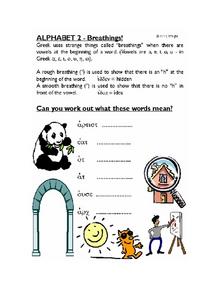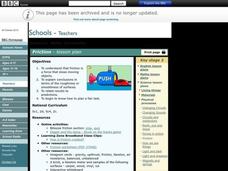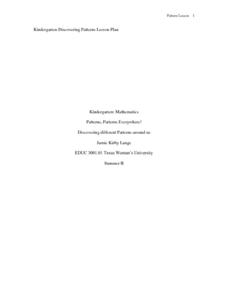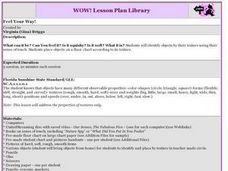Curated OER
One of Our Five Senses - Touch
The wonderful world of Oobleck is entered in order to awaken your learner's sense of touch! As a warm up, learners put their hands in mystery bags in order to identify things that are wet, dry, hot, cold, hard, soft, rough, and smooth....
Curated OER
Alphabet 2-Breathings!
In this Greek breathing worksheet, students review the process of rough and smooth breathing and then figure out what sixteen words in Greek mean.
Alabama Learning Exchange
Mirror, Mirror on the Wall: Reflections of Light
Why can we see our reflection in a window but not a brick wall? Young physicists learn the Law of Reflection and various light properties that help them answer this and other questions about reflection. Use the PowerPoint to introduce...
Curated OER
Is Your Rock Smooth Or Rough?-- Venn Diagram
In this Venn diagram worksheet, students collaborate in a tallying activity as they ask classmates if their rocks are smooth, rough, or both. Results are shown on a Venn diagram.
Curated OER
Texture - Bumpy, Wrinkled, Smooth?
Students study textures and identify textures using satellite images. In this texture lesson, students study various objects and define their textures. Students feel crayon rubbings and sort them into groups. Students use a book with...
Curated OER
Friction
Students explore friction as a force that slows moving objects, explain conclusions in terms of the roughness or smoothness of surfaces, relate results to predictions, and begin to know how to plan a fair test.
Consortium for Ocean Science Exploration and Engagement (COSEE)
Arctic Smorgasbord
Though the walrus spends roughly one third of its time on land, it eats organisms that live on the bottom of the ocean. The first in a series of five, the lesson uses a variety of plant and animal cards to have scholars build an arctic...
Curated OER
Friction
Students review what force. In this science lesson, students determine which surfaces are rough and which are smooth by observing how an object moves on each surface.
Curated OER
7.012 Fall 2004 Section Self-quiz
This quiz just looks neat! It has two cell diagrams for biology class members to label. They also describe the function of each organelle. A prokaryotic and eukaryotic cell are displayed for them to compare, and then they fill in the...
Curated OER
Texture Pumpkins
I love art and so do children of all ages. Your very youngest learners explore texture as they examine texture on their person, in their classroom, and then apply it to neat clay pumpkins. They roll clay into balls, flatten them out, and...
Curated OER
Away You Go
Students build Lego cars which have two different types of tire surfaces. They roll them down ramps that have both rough and smooth surfaces to determine how friction affects the car as it rolls.
Curated OER
TE Lesson: Factors Affecting Friction
Students investigate the effect of weight on normal friction or the friction due to surface roughness. They tell about the effects of contact area that occurs as a result of molecular attraction by looking at data on line graphs.
Curated OER
Touch and Feel
In this touch and feel worksheet, students glue collected objects to the paper to match the description of how that object feels. Students use the words hard, soft, rough, bumpy, sticky, and smooth to describe objects.
Curated OER
Sorting Objects
First graders experiment with sorting. In this sorting lesson, 1st graders separate objects according to one attribute: smooth, rough, hard or soft.
Curated OER
Agents of Erosion
Fourth graders explore the agents of erosion. They observe rocks that are rough and unweathered and record observations. They investigate rocks rubbed with sandpaper and ones that are not and the effects that the sandpaper has on the...
Curated OER
Sensory Descriptors
Students feel items in a bucket and describe them using descriptive words. In this sensory descriptive lesson plan, students use words such as smoothe, rough, and bumpy.
Curated OER
Sentence Work on Derivative Nouns
Students, after reading about derivative nouns, bring in a rough draft to class.
Curated OER
How Does It Feel?
Students identify the textures of materials in their environments in order to expand their language, math, sensory, and observational skills. In this sensory activity lesson, students first write a list of different words to describe...
Curated OER
Illustrated Words - colored pencils
Students use images and lettering style to communicate the meaning of a specific word chosen for the composition. They make rich, smooth, layered areas of color using colored pencils.
Texas Woman’s University
Patterns, Patterns Everywhere!
Not only is pattern recognition an essential skill for young children to develop, it's also a lot of fun to teach! Over the course of this lesson, class members participate in shared readings, perform small group activities, and complete...
Curated OER
Feel Your Way!
Students investigate the sense of touch as they examine the texture of items in the classroom and from their homes. They watch a computer based video about the senses and draw items that are rough, smooth, soft, and hard.
Curated OER
Materials We Use
How can you tell if something is made out of wood, metal, or plastic? Kids use noise and visual cues to determine what various household items are made from. They then examine their toys at home and record the materials used to make...
Grand Erie District School Board
Model Cell Project
If you're finishing up a unit on cells, here's a great project to get kids collaborating and recalling what they've learned in a fun and tangible way. Small groups create plant or animal cells out of materials they have at home. They use...
Curated OER
Are You Aware?
Bring the five senses to life with a fun science experiment! Kindergartners and first graders read an explanation of the five senses, then identify which items Sophia can sense if she is blindfolded. A science explanation at the bottom...
Other popular searches
- Rough and Smooth Objects
- Science Rough and Smooth
- Science Words Smooth Rough
- Rough and Smooth Materials
- Rough and Smooth Activities
- Smooth and Rough
- Language Rough and Smooth

























